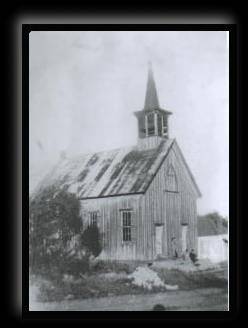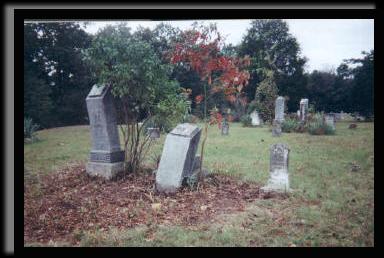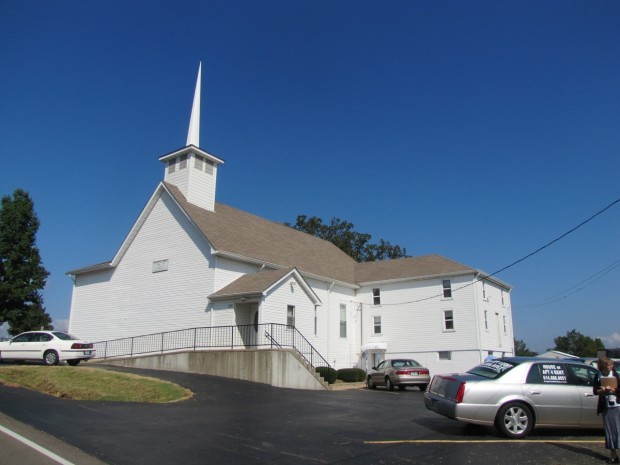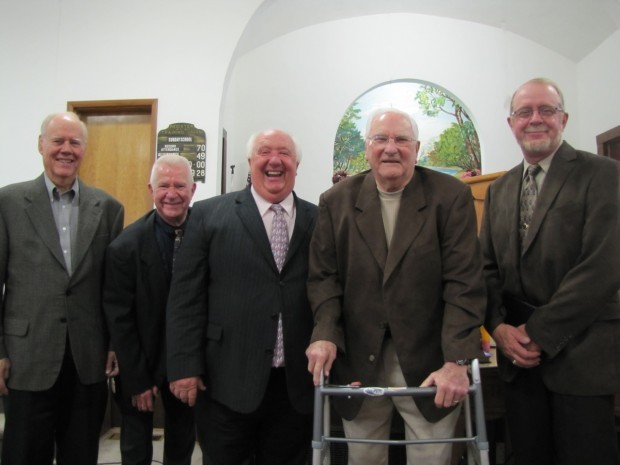
PREVIOUS PAGE

Standing silently, majestically, its steeple thrusting upward to the sky. A small, white church by the side of the road, facing the rolling farm lands to the South. Ah, what stories locked within its silent walls. Just a sign above the front door for the benefit of those who just pass by.
PROVIDENCE CHURCH
Missionary Baptist
Established September 11, 1831.
Over four generations ago, the farm folk who comprised the settlement known as Germania Settlement, three and a half miles west of the present city of Bonne Terre, and on the present highway 47, met and organized this church, where they could worship their God as they saw fit. Formerly all who resided within this area were compelled to follow the Roman Catholic Church, having been under the jurisdiction of Spain. Bonne Terre had not yet been founded, as the original settlement was known as Big River Mills and was located on Big River. It was later moved to the present site of, and became known as, Bonne Terre, Missouri.
I do not know just when this church building was erected, but believe 1870 would be nearly correct. I am sure I have heard my mother state that she attended church there when she was a baby. It was the first church I was taken to when a baby. I have heard the family tell how my late grandfather, Oscar Arenz, and his good neighbor, Uncle Jack (?) Norwine, donated the ground on which to build this church. As Grandfather moved to this locality in 1869 and Mother was born there in 1871, I believe the building may have been erected about 1870.
I was out there recently and the building looks just as it did when I was a small boy, except for some additions and a coat of drop siding on the outside walls. I am sure that if this siding was stripped off, the original walls of twelve-inch, virgin pine boards, about fourteen feet in length, would still be there, just as they were nailed there with wrought iron nails, vertically, just as they stood vertically in the virgin forests. If these boards had been kept well painted through the years, they would still be as good as the day they were placed there. A simple, plain building with those upsweeping boards and batten strips to the steeply climbing roof, topped with a belfry and a spire, thrusting upward to the sky. Its very simplicity giving it a dignity rarely seen in modern church buildings of today.
Grandfather Arenz was a Deacon and probably taught Sunday School classes. Grandmother taught a class there for forty years. She was a very devout soul and was known throughout the community as one "who knew her Bible." It seemed to me, as a boy, she could recite almost all of it from memory. But why not, she had spent a life time studying and reading it, and the Word and Way, probably the only magazine she ever read. One thing sure, the preachers learned not to argue with her about the Bible or the Baptist faith.
I can recall attending church there when, as a small boy, we were visiting my grandparents. I can remember those long winded, shouting preachers and the funny sound, like a mispronounced and, or was it merely an intoning of breath, (a lot of it was needed for those sermons) at the end of every sentence. Or maybe it was just a style country preachers had adopted, as I heard any number of them do the same thing. But it struck me as being rather funny at the time.
Another incident I never forgot--one Sunday we were sitting in our seats when an elderly couple came in and took the bench in front of us. As the broad-beamed, old gentleman raised his coat tails to sit down, there on the rear of his much worn, faded jeans, was a large patch, placed there by his industrious helpmate. She had apparently been out of cloth so used a piece of flour sack on which was still plainly visible the famous brand name and the words "Our very best." This, of course, brought a chuckle from me, and a reproving nudge from Mother, whose mouth muscles were strangely behaving.
Grandfather's home was just back of the church and he always tried to take the whole congregation home with him each meeting, for he, like most country folks, liked "company." This spelled lots of work for tiny Grandmother, but she didn't seem to mind. She just "hurrahed" (she always said hurrah instead of hurry) Mayme and the women guests, and a feast was soon on the table, all having been cooked the previous day.
Church Meeting, usually once a month, was a gala day in the lives of the community, when all the neighbors could get together. I can recall most of those names. There were the Settles, Houses, Ringers, Fites, Norwines, Hills, Longs, Spradlings, Kalals, Arenzs, and then there was a family by the name of Covington, newcomers, one of whose sons came "a courtin'" and carried away one of the Arenz girls, Mary Ellen (Mayme). I especially recall the Kalal family. They were Bohemian, and Mrs. Kalal was a motherly old soul who made the largest, best cookies I ever tasted. She had large jars of them and just loved to feed them to growing boys, washed down with large glasses of rich, cold milk. They lived in the place in front of the church and when I passed there recently I saw the name T. Kalal on a mail box. They had a son named Tom.
The small school house standing beside the church looks just as it did when I was a boy. I do not know if it is the same building in which Mother attended school, but I believe it may be the original building, remodeled, however. Just below this was a fine spring, which I presume is still there.
In those good old days, the big event of the year was Basket Dinner Sunday. We always tried to get out to Grandfather's on that day. That was something worth attending. I can still see those tables loaded with large baskets and tubs of good things to eat and I wondered how those tables could stand up under the load as the women folks busied themselves putting out the food while the menfolks made a fire to brew the huge pots of coffee. I guess all the people were worried about those tables standing the strain, too, from the way they hurried to lighten the load. The thing that sticks in my memory most were those stacks of apple pies, one layer on top of another, just like cakes, and those big cakes. Now that was my department, for I dearly loved sweets, especially apple pie and coconut cake. I always had more than I could hold, but never as much as I wanted. Oh, for the capacity and appetite of a boy.
We pause and wonder how many more generations may be privileged to worship in this small white church by the side of the road.
That little white church by the roadside
Silently watching the years roll by.
Man's youth; maturity; his even-tide,
A funeral cortege; a tear; a sigh.
Generations may come, generations may go,
As time marches relentlessly by.
But the little white church stands there, so
It can thrust its emblem of hope to the sky.
To remind the traveler, as he passes by,
Intent on his journey along life's way.
That he should thrust his mind to the sky,
So his soul may travel that path some day.
Copyright 1959, by Joseph O. Covington. All rights reserved.

Germania/Providence Baptist Church Cemetery
(Graves in Center of Picture are (l-r) Conrad Norwine, Jr., Elender Norwine
(his wife),
Elender Arzetta Norwine (their 6 month old chid).
Note: The photos of the church and school depicted and linked to above on this page were supplied by Joseph Wilkson.

DAILY JOURNAL, Park Hills, Missouri/September 15, 2011.
Church celebrates 180 years of history, worship
By K.R. JENKINS/Daily Journal Staff Writer
On the same day that most people in this country and many around the world were remembering the tragic events of the Sept. 11, 2001 terrorist attack on America, a country church located several miles outside Bonne Terre celebrated its 180th anniversary with a special homecoming service and dinner.

Speaking at the special homecoming service is former pastor, the Rev. Charlie
Shrum.
A potluck dinner was held following the service.
While the membership of Providence Baptist Church joined their fellow Americans in recalling the sudden and tragic deaths of more than 3,000 people on a clear and crisp Tuesday morning 10 years ago, they also felt a sense of pride in the many years of ministry that God has allowed the church to enjoy since its inception in the fall of 1831.
Church historian Darla Myers told the Daily Journal, �I think about the pioneer men and women who settled this area. Many of them were immigrants. They traveled here from the southern and eastern states to take advantage of Spanish land grants. This area was considered �the west� in those days. These early settlers were of hardy stock, clearing land, building houses, planting crops and raising their families.�
On Sept. 11, 1831, Myers said a group of 20 people met for the purpose of forming a church, choosing the name Providence Baptist Church.
�The fledgling congregation continued to meet in members� homes until March, 20, 1832, when the records state that they met at �Providence meeting house,�� continued Myers. �The first church was built on the banks of Big River, on the property of charter member Alfred Mitchell. My father, Marvin House, has an old land survey of the time and it clearly shows Mitchell�s property. Several of Mitchell�s neighbors were also charter members of the church.�
The site of the original church was in the Blackwell area, about five miles north �as the crow flies� directly behind its current location.
�Apparently, a preacher was not appointed during the very early years, because church records frequently mention various men delivering messages,� said Myers. �In those days, circuit riding preachers made the rounds of country churches, and men in the church filled in whenever needed.�
During the years Myers served as church clerk, she says she was fascinated by the old church records and looked up as much information as she could. In the Aug. 21, 1832 meeting, the clerk recorded the following: �...the male members of this church each agree to contribute 50 cents for the support of a traveling preacher within the bounds of this association.�
Myers said the old records mention many of the church�s preachers by name, but it is unclear who the first pastor was.
In the years that followed, the church moved several times. In 1838 Myers said the church voted to sell the original building to Mitchell and, in 1839, decided to build a �meeting house on the opposite side of the branch from the camp grounds, on a level piece of ground.�
Conrad and Eleanor Norwine and Adam and Margaret House donated a portion of their properties to �build a place of worship and public education� in 1850. The former school house � now used by the church as a fellowship hall and additional education space � was the first church built on the current property.
Myers said, �I�ve poured over the records trying to determine exactly when the current church was built. I know a committee of five was appointed to �count money and secure a little one acre of land to build a church house� in 1876. In 1877, the church trustees were directed to sell the shed attached to the old church �to the highest bidder for cash and the proceeds thereof to be appointed towards the new church house.� I still don�t know when the �new church house� was built, but I�m going to keep looking.�
The church gave the old church�s title to the school district in 1877, but the building changed hands again in 1960, when Providence paid $347.50 to the Bonne Terre School District to buy the building back.
�It�s interesting to note that our church was founded only 35 years after the signing of the Declaration of Independence,� continued Myers. �Andrew Jackson was president of the United States � and there were only six presidents before him. The classic song, �My Country, �Tis of Thee� was performed for the first time in Boston on July 4, 1831. The state of Missouri had been in existence a mere 11 years. On a local level, only one Baptist church in our association pre-dates Providence � Liberty Baptist in Belgrade, which was founded in 1816.�
In recalling her years as a member of Providence Baptist Church, Myers recalled, �There are so many precious memories � both from my childhood and those of my own children. Christmas programs, vacation Bible schools, homecoming services, baby dedications, baptisms, weddings and funerals. There have been pool parties, spring cleanup days, revivals, basket dinners, ice cream socials, gospel singings and fervent prayer meetings. I remember Easter sunrise services and breakfasts, secret pal parties, Easter and Christmas cantatas and canned food drives. I have been blessed to see my three children saved here, grow up here and take on leadership roles in the church.�
The church�s current pastor, the Rev. Roger Driggs, came to the church in June. His first Sunday in the pulpit was June 19, Father�s Day. He said that while the church has a wonderful history, he accepted the call as pastor because of the mission mindset of its current membership.
�This is a congregation that is brokenhearted for the community,� he said. �They have a love for one another and a love for the Lord.�
In last Sunday morning�s homecoming service, Rev. Driggs told the congregation, �We are celebrating what God has done over the past 180 years through committed people. Our responsibility � if the Lord tarries another 180 years � is to leave a similar history for those who follow us. If we keep Christ number one, we will make history.�

Former Providence Baptist Church pastors who attended
Sunday's homecoming were, from left,
the Rev. Emmett Barnes, the Rev. Grady Evans, the Rev. Charlie Shrum, and the
Rev. John Garland.
At far right is current pastor, the Rev. Roger Driggs.
The information on this site is provided free for the purpose of researching your genealogy. This material may be freely used by non-commercial entities, for your own research. The information contained in this site may not be copied to any other site without written "snail-mail" permission. If you wish to have a copy of a donor's material, you must have their permission. All information found on these pages is under copyright of Oklahoma Cemeteries. This is to protect any and all information donated. The original submitter or source of the information will retain their copyright. Unless otherwise stated, any donated material is given to MOGenWeb to make it available online.